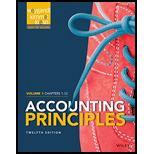
Accounting for Receivables:
Receivables are defined as the amounts that are due to a firm by its customers and other parties. Receivables include all those assets that arise due to the primary operations of a firm and those representing cash that is to be collected from all external parties who owe money to the firm.
Receivables are broadly categorized into trade-receivables and non-trade receivables. Trade receivables refer to those receivables that occur due to the sale of goods and services in the normal course of business. Non-trade receivables refer to the amounts that occur due to third parties from transactions outside the primary course of business.
To prepare: The
Want to see the full answer?
Check out a sample textbook solution
Chapter 9 Solutions
Accounting Principles, Volume 1: Chapters 1 - 12
- Need soln this No AIarrow_forwardWalsh plc sells wash machines and provides a one-year warranty against faults occurring after sale. Platt estimates that if all goods under warranty at its statement of financial position date of 31 December 2022 need minor repairs the total cost would be £ 6 million. If all the products under warranty needed minor repairs the total cost would be £ 24 million. At 31 December 2023 these amounts have risen to £ 7 million and £ 26 million respectively. Based on previous years` experience, Walsh estimates that the 80% of the products will require no repairs, 18% will require minor repairs and 2% will require major repairs. During the year ended 31 December 2023 actual costs of repair under the warranty amounted to £ 1,400,000. Required: a. b. What are the distinctions between liabilities, provisions and contingent liabilities under IAS 37 “Provisions”? Explain the accounting treatment of the warranty in Walsh plc`s financial statements for the year ended 31 December 2023, qualifying…arrow_forwardPlease provide answer this financial accounting questionarrow_forward
- Smith plc commenced two projects on 1 January 2023. The following details relate to them as at 31 December 2023. Cost to date Progress billings invoiced Progress billings received Estimated future costs Estimated final contract price Project 1 Project 2 ₤'000 ₤'000 380 110 290 70 210 55 120 320 650 430 Smith plc uses the percentage completion method based on costs (cost to date/total costs) to account for construction contracts. The policy of Smith plc is that project outcomes can only be reliably measured when a project is at least 35% complete. Required a. Illustrate the five-step method under the IFRS 15 Revenue from Contracts with Customers.arrow_forwardCan you solve this general accounting problem with appropriate steps and explanations?arrow_forwardPlease explain the correct approach for solving this general accounting question.arrow_forward

 AccountingAccountingISBN:9781337272094Author:WARREN, Carl S., Reeve, James M., Duchac, Jonathan E.Publisher:Cengage Learning,
AccountingAccountingISBN:9781337272094Author:WARREN, Carl S., Reeve, James M., Duchac, Jonathan E.Publisher:Cengage Learning, Accounting Information SystemsAccountingISBN:9781337619202Author:Hall, James A.Publisher:Cengage Learning,
Accounting Information SystemsAccountingISBN:9781337619202Author:Hall, James A.Publisher:Cengage Learning, Horngren's Cost Accounting: A Managerial Emphasis...AccountingISBN:9780134475585Author:Srikant M. Datar, Madhav V. RajanPublisher:PEARSON
Horngren's Cost Accounting: A Managerial Emphasis...AccountingISBN:9780134475585Author:Srikant M. Datar, Madhav V. RajanPublisher:PEARSON Intermediate AccountingAccountingISBN:9781259722660Author:J. David Spiceland, Mark W. Nelson, Wayne M ThomasPublisher:McGraw-Hill Education
Intermediate AccountingAccountingISBN:9781259722660Author:J. David Spiceland, Mark W. Nelson, Wayne M ThomasPublisher:McGraw-Hill Education Financial and Managerial AccountingAccountingISBN:9781259726705Author:John J Wild, Ken W. Shaw, Barbara Chiappetta Fundamental Accounting PrinciplesPublisher:McGraw-Hill Education
Financial and Managerial AccountingAccountingISBN:9781259726705Author:John J Wild, Ken W. Shaw, Barbara Chiappetta Fundamental Accounting PrinciplesPublisher:McGraw-Hill Education





